Lielākajai daļai populārāko lietojumprogrammu ir drošais režīms, kas ļauj lietotājiem palaist programmu ar ierobežotu funkcionalitāti, kad viss nedarbojas tā, kā vajadzētu. Tas attiecas uz programmu Outlook - sarežģītu e-pasta pārvaldnieku, kas izmanto drošo režīmu, lai apietu daudzus jautājumus, kas neļauj tai startēt. Varat speciāli palaist programmu Outlook drošajā režīmā, taču tas var sākties arī pats šajā režīmā.

Ja vien kādu iemeslu dēļ pats neinstalējat drošo režīmu , es jums neiesakām turpināt izmantot programmu Outlook šajā režīmā. Jūs nevarēsit saglabāt veidnes, preferences un cita starpā nevarēsit izmantot viedos tagus. Ja jums ir šāda veida situācija, ieteicams izturēties pret drošo režīmu kā diagnostikas rīku un atrisināt problēmu.
Kad OutLook tiek izmantots drošais režīms
Outlook regulāri atjauninās sistēmas reģistru, lai jaunie instalētie paplašinājumi varētu darboties tā, kā vajadzētu. Ja programma palaišanas laikā atklāj problēmu, kas neļauj tai darboties, tā automātiski ieslēdzas drošajā režīmā . Parasti tas notiek tūlīt pēc jauna papildinājuma instalēšanas, kas nedarbojas labi ar jūsu Outlook versiju.
Drošo režīmu varat aktivizēt pats, atverot logu Palaist un ierakstot Outlook / safe un nospiežot Labi .

Gadījumā, ja programma Outlook automātiski startē drošajā režīmā , tā parasti ir zīme, ka kaut kas nedarbojas pareizi. Dažreiz programmai Outlook izdosies precīzi noteikt pievienojumprogrammas komponentu, kas kavē Outlook normālu palaišanu. Ja tiek prasīts atspējot kļūdaino komponentu, pamēģiniet un pārliecinieties, vai Outlook izdodas palaist normāli.

Iespējamie drošā režīma aktivizētāji
Ja izmantojat 2010. gada versiju, visticamāk, problēmu izraisa KB3114409 atjauninājums, kas liek programmai Outlook startēt drošajā režīmā un atjaunot noklusējuma iestatījumus. Gadījumā, ja izmantojat vecāku Outlook versiju, piemēram, 2007. vai 2003. gadu, problēma var būt saistīta ar Windows meklēšanas pakalpojumu. Nepareizs pievienojumprogramma var arī būt pretrunā ar jūsu Outlook versiju līdz vietai, kur jūs piespiedīsit to sākt drošajā režīmā .
Šie ir tikai trīs no potenciālajiem vainīgajiem, taču cēloņi var rasties daudzās vietās.
Zemāk ir labojumu kolekcija, kas daudziem lietotājiem jau ir palīdzējusi novērst Outlook darbību drošajā režīmā . Izpildiet iepriekš minētās metodes secībā atbilstoši savai Outlook versijai, līdz atrodat labojumu, kas atrisina jūsu problēmu.
1. metode: pievienojumprogrammu atspējošana drošajā režīmā (visas Outlook versijas)
Tas ir izplatīts gadījums visās Outlook versijās, sākot no Outlook 2007 līdz Outlook 2016 . Tas notiek tāpēc, ka noteikti papildinājumi būs pretrunā ar jūsu Outlook versiju. Tas ir vēl ticamāk ar novecojušiem pievienojumprogrammām, kas instalētas jaunākajās Outlook versijās.
Piezīme. Ja ABBYY FineReader pievienojumprogrammu esat instalējis pirms šīs kļūdas sākšanās, veiciet tālāk norādītās darbības, lai noņemtu papildinājumu no savas Outlook versijas.
- Pārbaudiet, vai programma Outlook ir drošajā režīmā, pārbaudot, vai uzdevumjoslas ikonai ir izsaukuma zīme.

Piezīme. Varat arī apstiprināt, apskatot, vai ekrāna augšējā sadaļā pamanāt (drošais režīms).

- Tagad izvērsiet cilni Fails un noklikšķiniet uz Opcijas .

- Tagad noklikšķiniet uz cilnes Pievienojumprogrammas . No turienes piekļūstiet nolaižamajai izvēlnei blakus Pārvaldīt un sarakstā atlasiet COM pievienojumprogrammas . Noklikšķiniet uz Go, lai turpinātu.
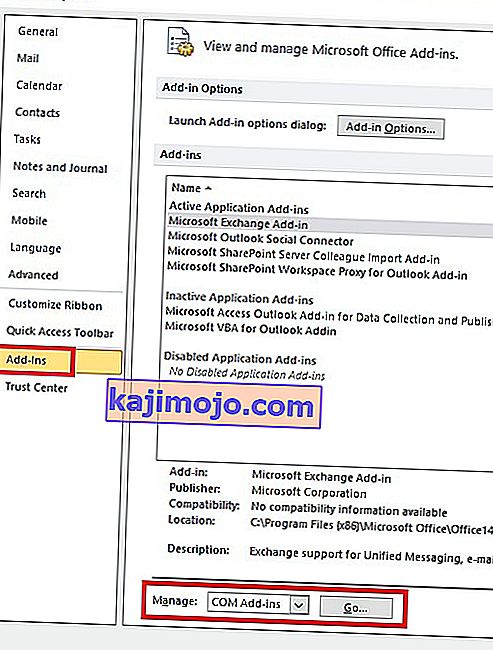
- Šajā brīdī jums vajadzētu uzņemt pievienojumprogrammu saraksta ekrānuzņēmumu un saglabāt to kaut kur sasaucamā vietā. Tas palīdzēs atjaunot parasto Outlook konfigurāciju, ja pēc pievienojumprogrammu atspējošanas rodas kādi traucējumi.
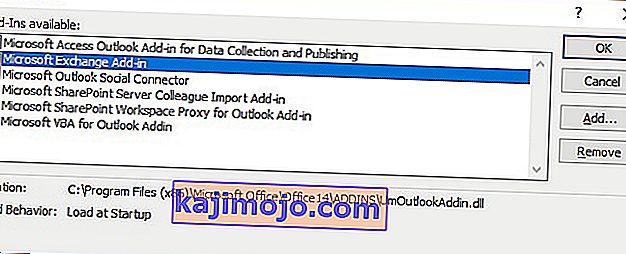
- Atspējojiet katru ierakstu (notīriet atlasītās izvēles rūtiņas) un nospiediet Labi .
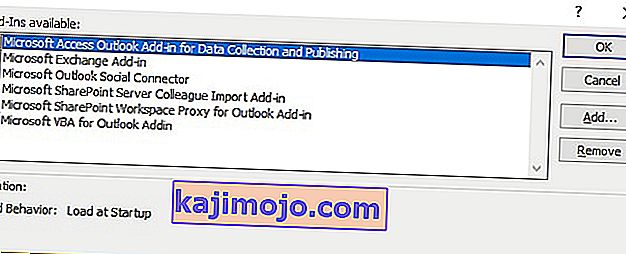 Piezīme. Vēl neesiet nospiests Noņemt . Vispirms mums jāapstiprina, ka viņi izraisa šo problēmu.
Piezīme. Vēl neesiet nospiests Noņemt . Vispirms mums jāapstiprina, ka viņi izraisa šo problēmu. - Aizveriet programmu Outlook un vēlreiz atveriet to. Ja programma tiek palaista normālā režīmā, jūsu problēma ir atrisināta.
Piezīme: Gadījumā, ja tas joprojām tiek palaists drošajā režīmā , dodieties uz File Options> Add-ins un atkārtoti iespējojiet pievienojumprogrammas, kuras mēs atspējojām 5. darbībā, un pārejiet uz 2. metodi .
- Atgriezieties sadaļā Fails> Opcija> Pievienojumprogrammas un sistemātiski atkārtoti iespējojiet katru pievienojumprogrammu, līdz atklājat konfliktu izraisošo.
- Atlasiet to un nospiediet Noņemt .
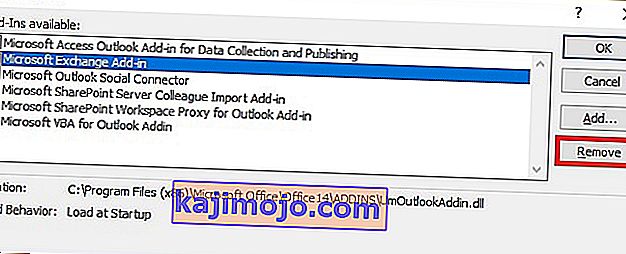
- Restartējiet programmu Outlook un pārbaudiet, vai tas tiek palaists normālā režīmā.
2. metode: datora atjaunošana, izmantojot sistēmas atjaunošanu (visas Outlook versijas)
Sistēmas atjaunošana ir Windows funkcija, kas lietotājiem ļauj atjaunot datora stāvokli iepriekšējā laika posmā. Tas kalpo mūsu mērķim, ja mēs varam atgriezties stāvoklī, kas bija iepriekš, kur Outlook sāka darboties nepareizi. Lūk, kā rīkoties:
- Turiet Windows taustiņu un nospiediet R. Ierakstiet rstrui.exe un noklikšķiniet uz Labi .
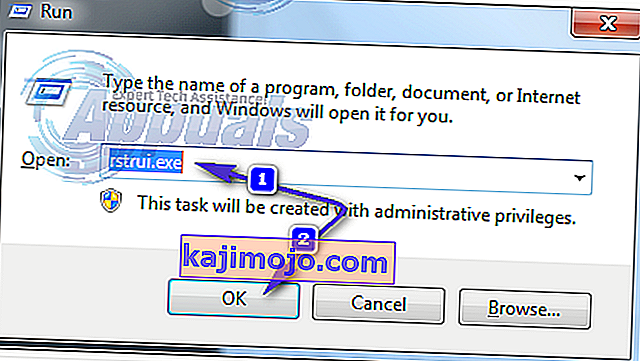
- In System Restore logu, atlasiet Izvēlēties citu atjaunošanas punktu un hit Tālāk.
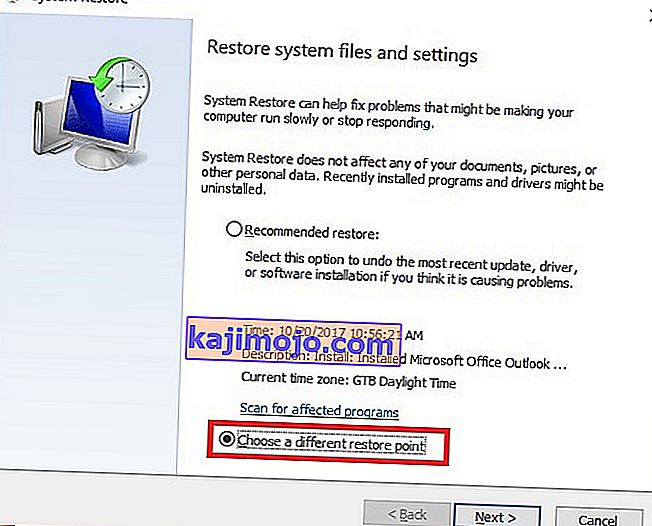
- Biezu rūtiņu blakus Rādīt vairāk atjaunošanas punktu.
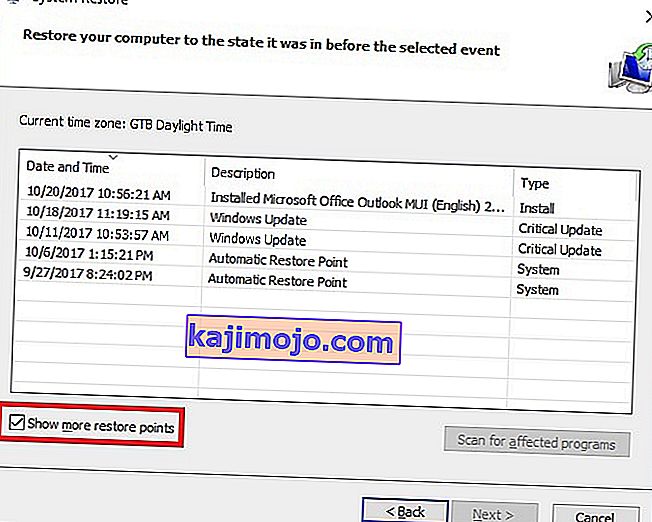
- Atrodiet punktu, kad programma Outlook darbojās, pēc tam izvēlieties šo atjaunošanas punktu un turpiniet izpildīt ekrānā redzamos norādījumus, lai atjaunotu datoru agrāk.
- Kad tas būs izdarīts, sistēma sāks atjaunot. Pēc atjaunošanas beigām pārbaudiet, vai programma Outlook darbojas. ja tas nenotiek, pārejiet pie 3. metodes .
3. metode: atjaunojiet iepriekšējo Outlook versiju
Ja darbvirsmas OS atjaunošana uz vecāku versiju nedarbojās, mēģināsim atjaunot programmu Outlook iepriekšējā versijā. Lūk, kā:
- Noklikšķiniet uz Sākt un meklēšanas dialoglodziņā ierakstiet Outlook.exe . Ar peles labo pogu noklikšķiniet uz tā un izvēlieties Rekvizīti .
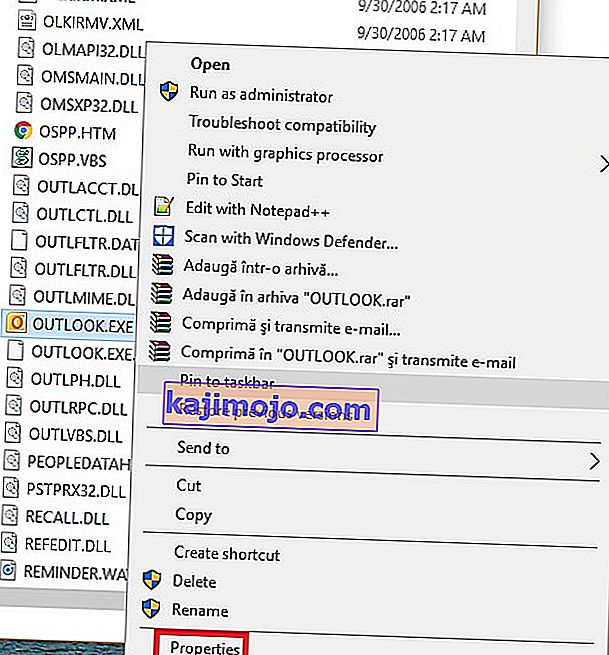
- Pēc tam dodieties uz cilni Iepriekšējās versijas un atrodiet failu Outlook.exe , kuram ir datums, kad tas darbojās. Noklikšķiniet uz Atvērt, lai redzētu, vai tas darbojas un tiek atvērts bez drošā režīma .
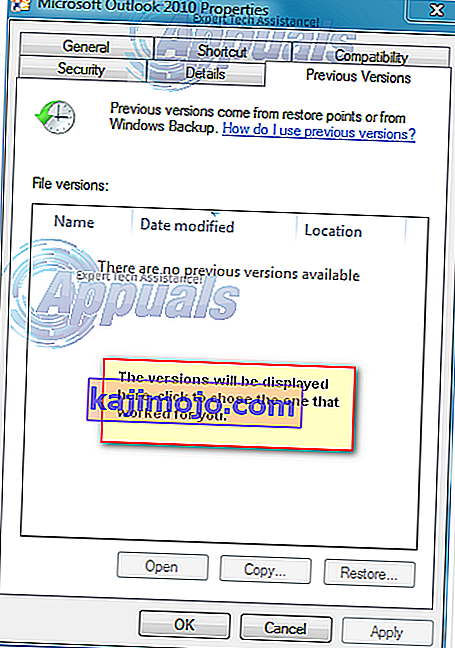 Piezīme. Pārliecinieties, vai nedarbojošais Outlook, kas iepriekš tika atvērts drošajā režīmā, ir aizvērts, jo tagad mēs izmantojam vienu no iepriekšējās versijās saglabātajām kopijām. Dariet to pašu visām tur uzskaitītajām versijām. Atveriet / aizveriet, līdz redzat to, kas tiek atvērts bez drošā režīma. Ja tas patiešām darbojas, turiet logu atvērtu.
Piezīme. Pārliecinieties, vai nedarbojošais Outlook, kas iepriekš tika atvērts drošajā režīmā, ir aizvērts, jo tagad mēs izmantojam vienu no iepriekšējās versijās saglabātajām kopijām. Dariet to pašu visām tur uzskaitītajām versijām. Atveriet / aizveriet, līdz redzat to, kas tiek atvērts bez drošā režīma. Ja tas patiešām darbojas, turiet logu atvērtu. - Pieņemot, ka tagad darbojas Outlook versija bez drošā režīma no vienas no iepriekšējām versijām. Turiet Windows Key un nospiediet R . Ierakstiet taskmgr un noklikšķiniet uz Labi .
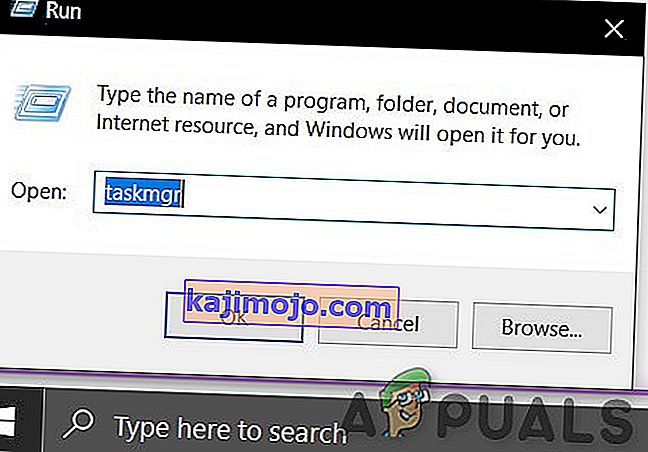
- Jo Task Manager logu, pārejiet uz procesu Tab, atrodiet outlook.exe peles labo pogu noklikšķiniet uz tā un izvēlieties Atvērt faila atrašanās.
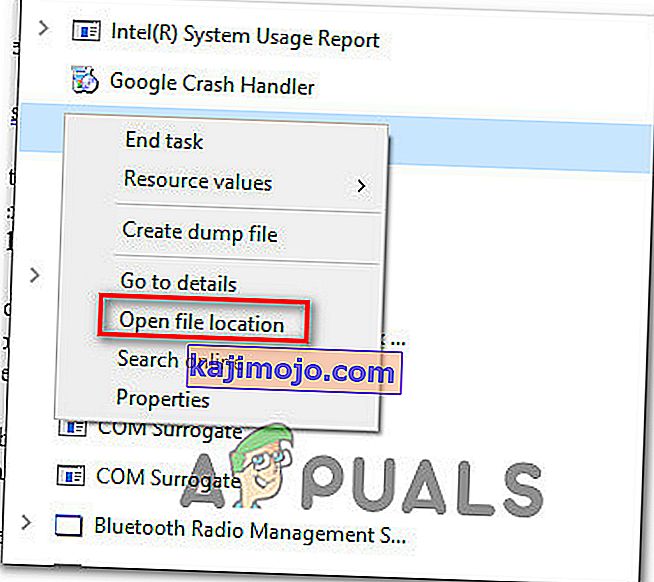
- Kopējiet visus failus no nākamā loga un pēc tam pārejiet uz C: \ Program Files (x86) \ Microsoft Office \ Office. Šeit ielīmējiet iepriekš nokopētos iesniegtos failus.
- Mēģiniet vēlreiz atvērt programmu Outlook un pārliecināties, vai tā sākas normālā režīmā.
4. metode: KB3114409 atjauninājuma atinstalēšana (Outlook 2010)
Kādreiz 2015. gadā Microsoft izdeva drošības plāksteri, kas lika Outlook darboties drošajā režīmā un atgrieza to pēc noklusējuma konfigurācijas. Lietotāju izveidotās konfigurācijas netiek zaudētas uz visiem laikiem, un tās atgriezīsies, kad programmai Outlook izdosies palaist normālā režīmā.
Ja jums ir šī problēma, ir divi veidi, kā rīkoties tālāk. Tā kā Microsoft izdeva atjauninājumu, kas novērš KB3114409 radīto problēmu , mēs to varam instalēt, izmantojot slikto atjauninājumu. Cits ceļš būtu vienkārši atinstalēt KB3114409 .
We highly recommend you to go for installing the official Microsoft update fix. But regardless of which option you opt for, we will guide you through the whole process.
Using the official Microsoft fix
Microsoft update KB3114560 was issued specifically to fix the damage done by KB3114409. As a rule of thumb, you should always install security updates from the official website. Here’s what you need to do:
- Access this official link and click on one of the two different update versions, according to your PC specs.
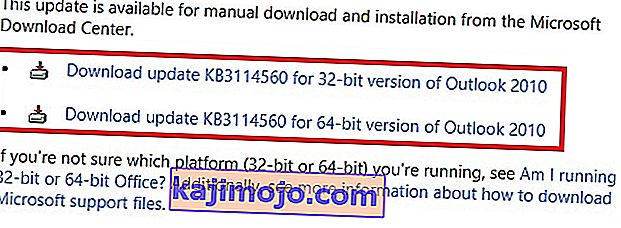
- Select the default language of your Outlook program and click on the Download button.
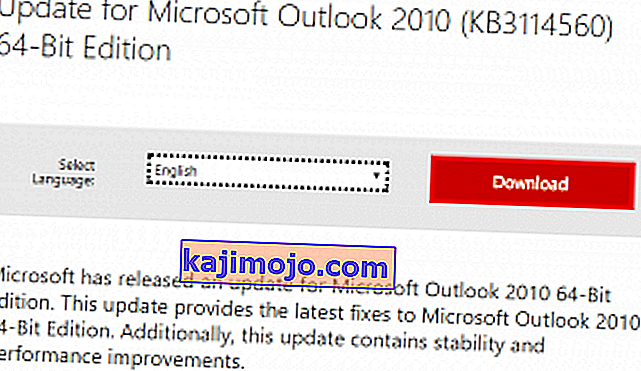
- Once the update has been downloaded, open the executable and follow through with the installation process.
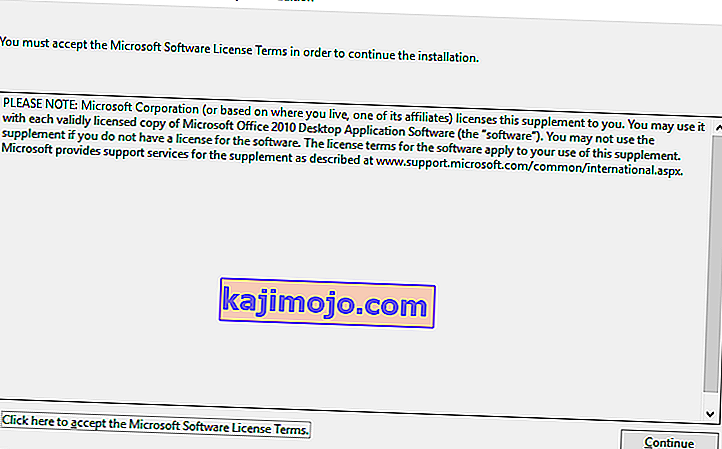
- Restart your PC, open Outlook again and see if the issue has been resolved.
Uninstalling the KB3114409 update
- Close Outlook completely.
- Open Control Panel, click on Uninstall a program.
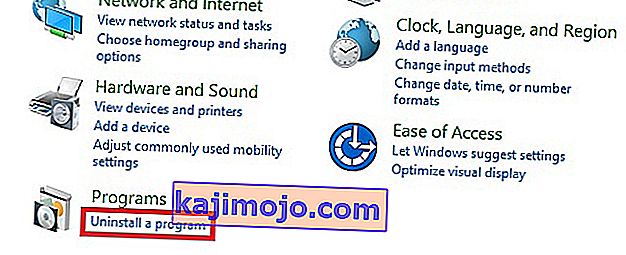
- Once you’re in the Programs and Features window, click on View installed updates.
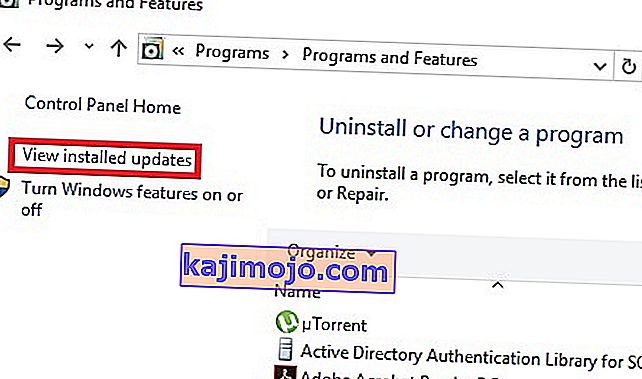
- Use the Search Installed Updates search bar in the top-right corner to search for the bad update (KB3114409 ).

- Once you manage to identify the bad update, click the Uninstall button and follow through with the confirmation prompts.
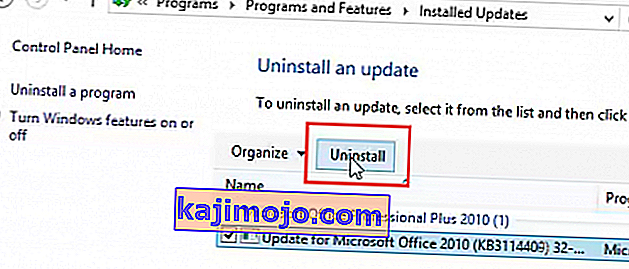
- Restart your PC, open Outlook and see if the issue repeats.
Method 5: Doing an Outlook Profile reset (All Outlook versions)
If you experience hanging at the initial Outlook splash screen (right before it initiates Safe Mode), you might need to do a profile reset. Here’s how to do it:
- Go to Control Panel > Mail and click on Show Profiles.
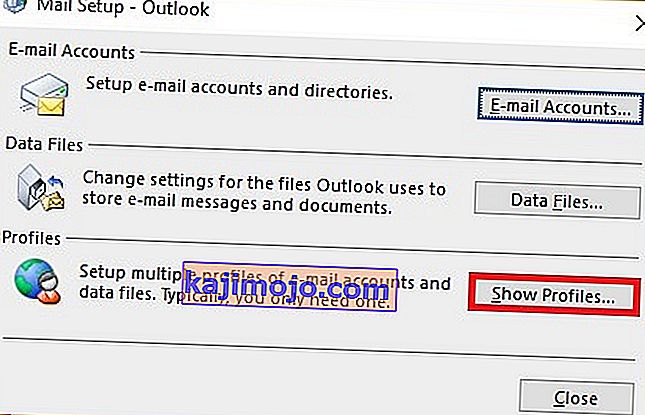
- Now, create a new profile by clicking the Add button. Insert a name and hit OK.
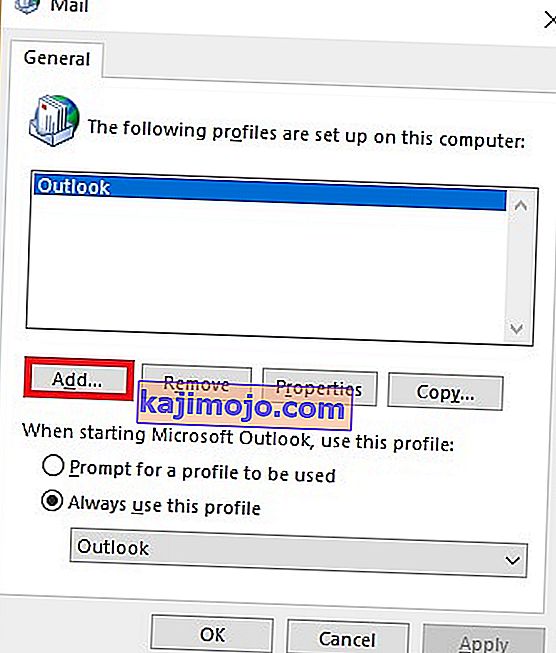
Note: Do not delete the original profile, because we don’t know if this will end up fixing the issue.
- Go through the steps of configuring your email account with Outlook. Make sure to use the same email that you have on the already created profile.
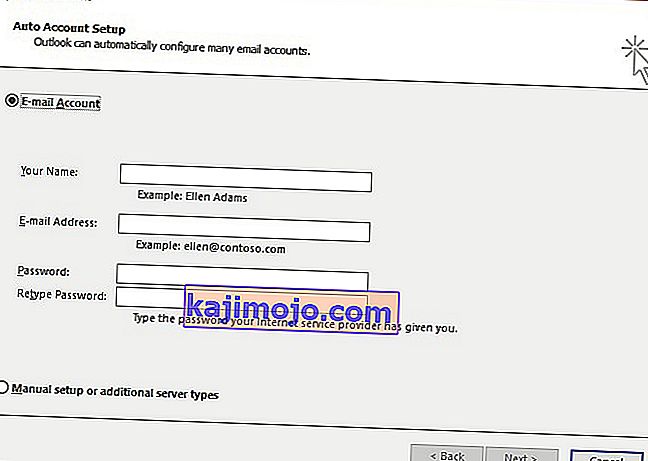
- Now return to the Mail window and make sure the profile you’ve just created is being used by default. Hit Apply to confirm your selection.
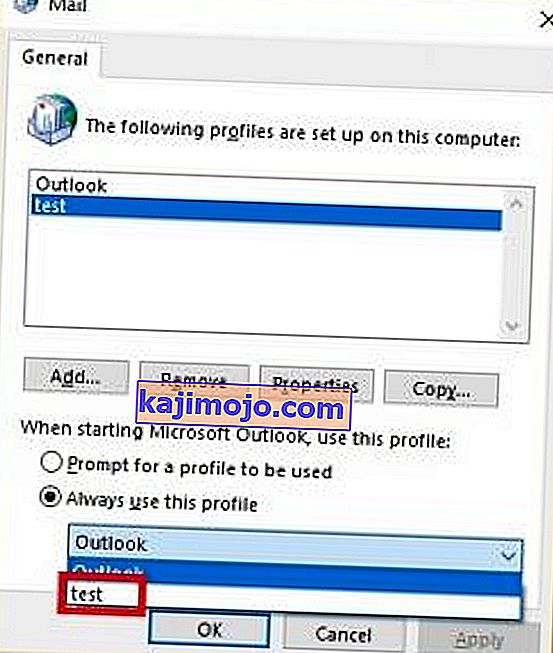
- Start Outlook again and see if it manages to start in normal mode after the profile reset.
Method 6: Checking the PST folder for corruption (All Outlook versions)
Another common cause for Outlook starting in Safe Mode is the Personal Folders File (PST). In the event that it becomes very large, or some files inside are corrupted, it might prevent the program from starting in normal mode. Luckily, you can easily check for corruption by using a Microsoft Repair tool called Scanpst.exe. Here’s what you need to do:
- Close Outlook completely and navigate to C:\ Program Files or C:\ Program Files (x86), depending on which version of Outlook you use.
- Use the search box in the top-right corner to search for SCANPST.exe.
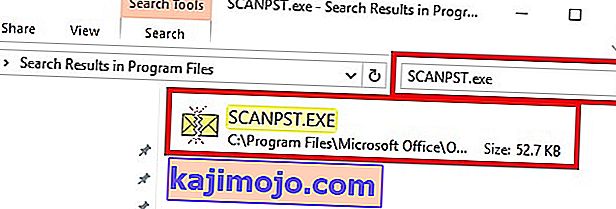 Note: If you don’t manage to find the SCANPST executable via the search bar, you need to navigate to the exact location. Here’s a list of the exact locations based on various Outlook versions:
Note: If you don’t manage to find the SCANPST executable via the search bar, you need to navigate to the exact location. Here’s a list of the exact locations based on various Outlook versions:2016: C:\Program Files (x86)\Microsoft Office\root\Office16 2013: C:\Program Files (x86)\Microsoft Office\Office15 2010: C:\Program Files (x86)\Microsoft Office\Office14 2007: C:\Program Files (x86)\Microsoft Office\Office12
- Open SCANPST.exe and set the path of the PST file you want to scan by using the Browse button. By default, the PST files are stored in Documents\Outlook Files. When you are ready, hit Start to begin the scan.
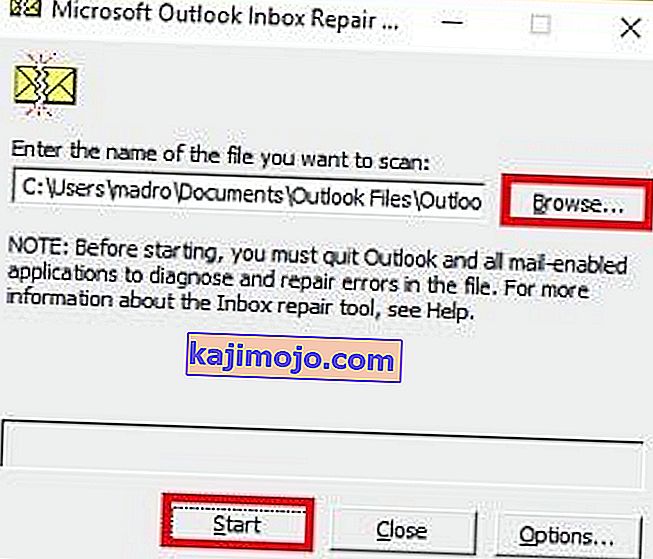
- If the scan uncovers errors or inconsistencies, click on the Repair button to fix them.
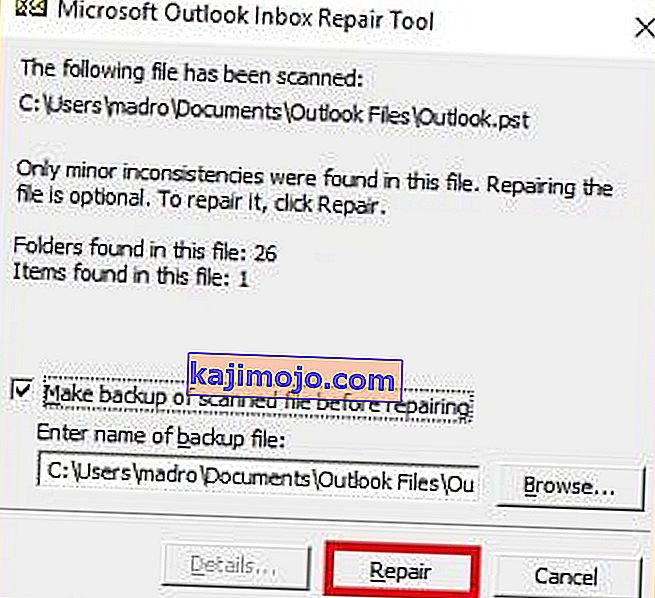
- Once the repair is done, restart Outlook with the profile that you’ve just repaired of errors and see if it starts in normal mode.
Method 7: Running the /resetnavpane command (All Outlook versions)
The navigation pane is that left portion of Outlook where you can oversee your folder list and access various icons to move between calendar, people, tasks, and mails. Sometimes, it can become glitched and prevent Outlook from starting in normal mode. Luckily, there is a command that removes any customizations to the navigation pane and gets rid of any glitch. Even better, this is done outside Outlook with ease. Here’s how:
- Close Outlook completely.
- Go to Start and access the Run application.
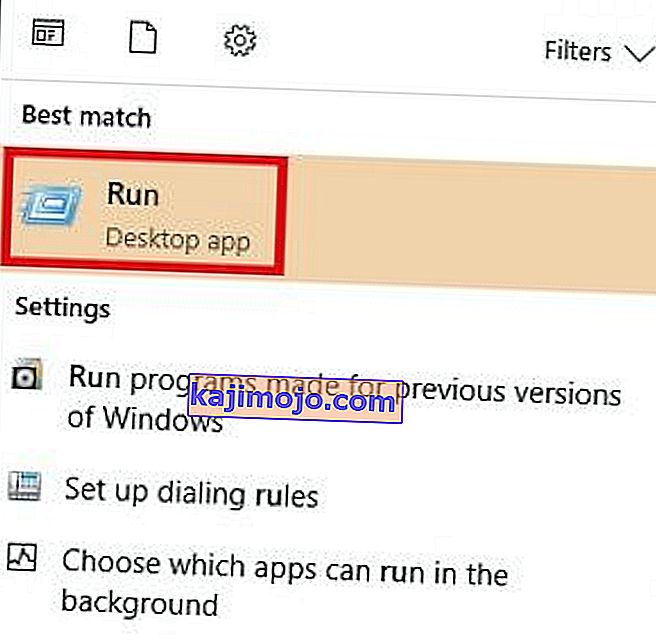
- Now, type Outlook.exe /resetnavpaneand hit OK.
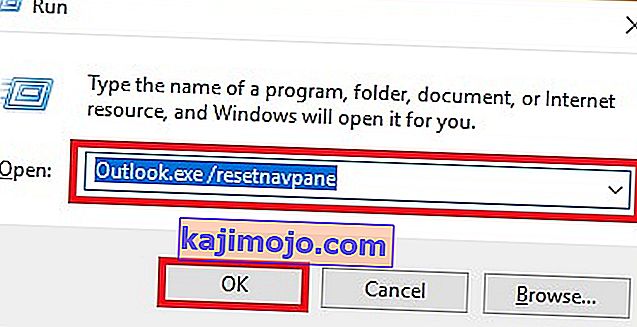 Note: Keep in mind that any customization to the navigation pane will be lost after you click on OK.
Note: Keep in mind that any customization to the navigation pane will be lost after you click on OK. - Shortly after, Outlook should automatically open in normal mode.
Method 8: Disabling compatibility mode
A lot of users have reported that they managed to start Outlook in normal mode after finding out it was running in compatibility mode. Compatibility mode is designed to help a program run as if it was running on an older operating system. As it turns out, turning off compatibility mode might just fix your Outlook Safe Mode problem. Here’s how:
- Close Outlook and navigate to the Outlook.exe on your computer. The exact path of it will differ, depending on your Outlook version. Here’s a list of the exact paths depending on your Outlook version:
2016 - C:\Program Files (x86)\Microsoft Office\root\Office16 2013 - C:\Program Files (x86)\Microsoft Office\Office 15 2010 - C:\Program Files (x86)\Microsoft Office\Office 14 2007: C:\Program Files (x86)\Microsoft Office\Office12

- Right-click on Outlook.exe and click on Properties.
- Now click on the Compatibility tab and make sure the box directly under Compatibility Mode is unchecked. Hit Apply to confirm your selection.
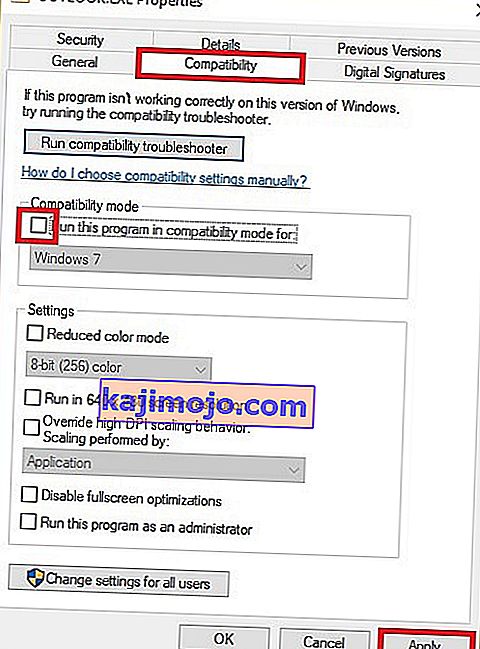
- Finally, open Outlook from the same Outlook executable and see if it manages to start in normal mode.
Method 9: Disabling hardware acceleration (All Outlook versions)
As it turns out, Outlook tries to use hardware acceleration whenever it can to make things as seamless as possible. If you’re Outlook forces itself into Safe Mode, it could very well be an issue with hardware acceleration. We can check to see if that’s the case by making some minor tweaks inside regedit. Here’s how:
- Go to Start and open the Run application.
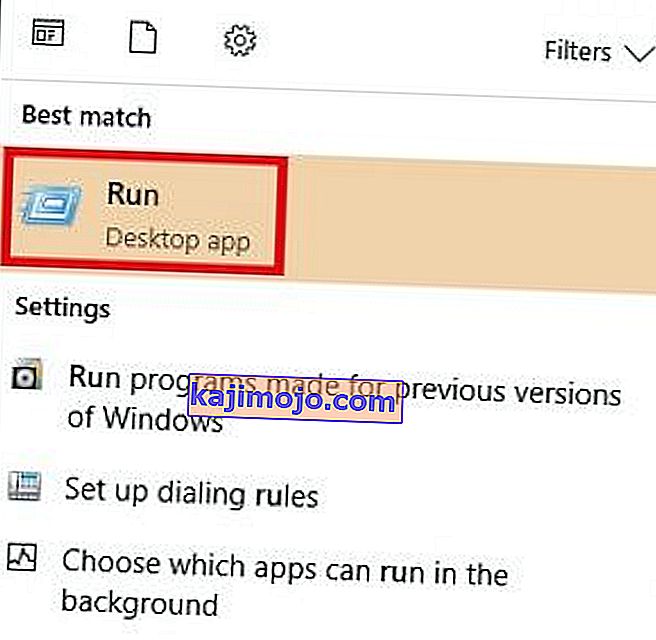
- Search for regedit and click OK to open the Registry Editor.
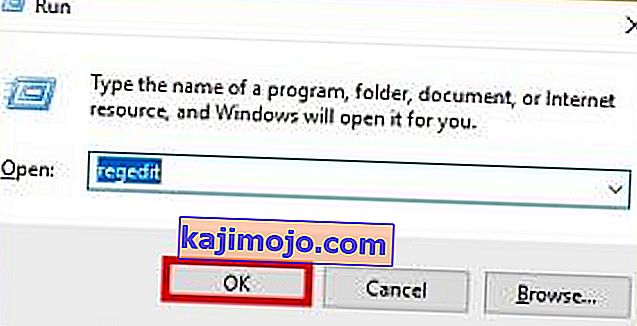
- Navigate your way to the following location
HKEY_CURRENT_USER\ Software\ Microsoft\ Office.
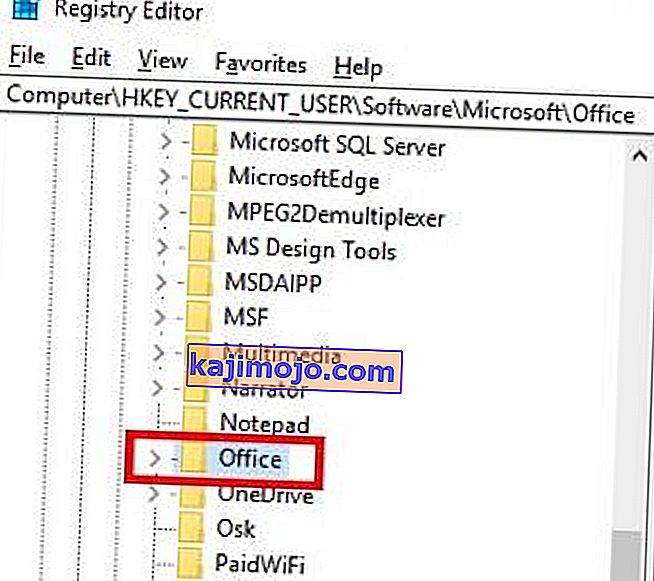
- Now, depending on which Outlook version you have, you might encounter different folders. You should either see a folder named 14.0, 16.0 or 8.0. Either way, click on the folder and double-click on the Common folder.
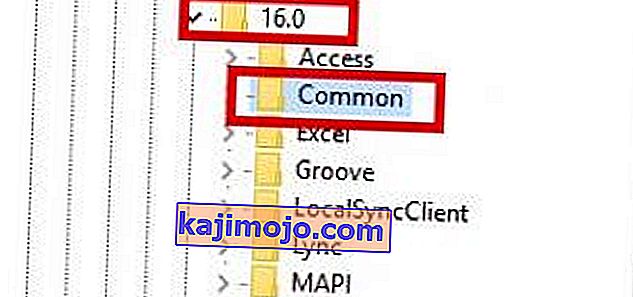
- Right-click anywhere in the Common folder, select New and click on Key and name it Graphics.
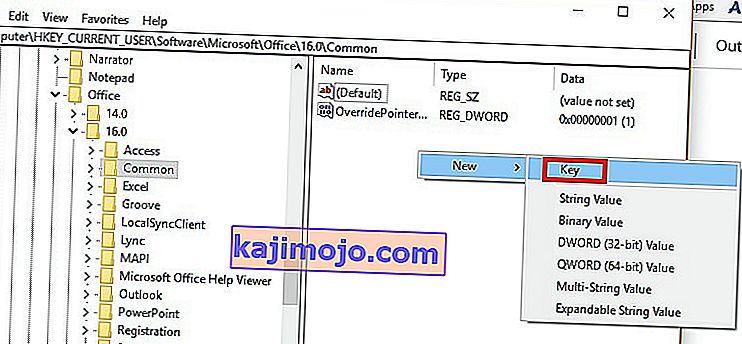
- Select the newly created Graphics folder and right-click on the right panel. From there, create a New Dword (32-bit) Value and name it DisableHardwareAcceleration.
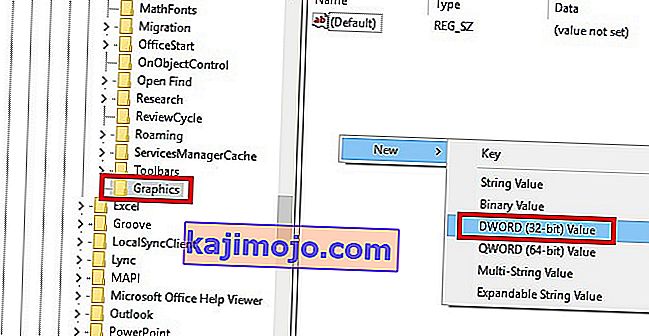
- Now double-click on DisableHardwareAcceleration and set the Value Data to 1 and hit Ok.
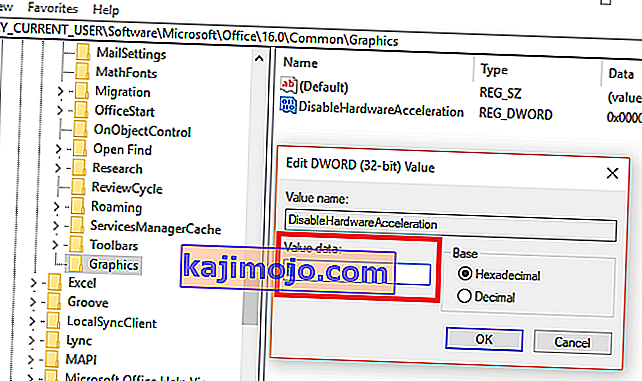
- Close regedit and open Outlook again to see if it starts in normal mode.
Method 10: Resetting the Safe Mode Registry Key (Outlook 2010)
If you have unsuccessfully followed all the methods above, there’s one more thing you can try. A final solution would be to try and prevent Safe Mode from kicking in by tweaking the registry key. But keep in mind that after you’ll follow the steps below, you won’t be able to use Safe mode in the future. At least not until you remove the key that we will create. Here’s what you need to do:
- Go to Start and open the Run application.

- Search for regedit and click OK.

- Navigate your way through HKEY_CURRENT_USER\ Software\ Microsoft\ Office.

- Now, depending on which Outlook version you have, you might encounter different folders. You should either see a folder named 14.0, 16.0 or 8.0. Either way, click on the folder navigate further to Outlook \ Security.
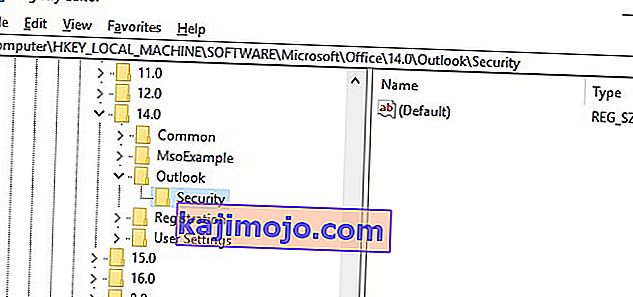 Note: If the Security folder is missing, Right-click > New > Key and type Security.
Note: If the Security folder is missing, Right-click > New > Key and type Security. - Right-click on the Security key and choose New > then DWORD (32-bit) Value.
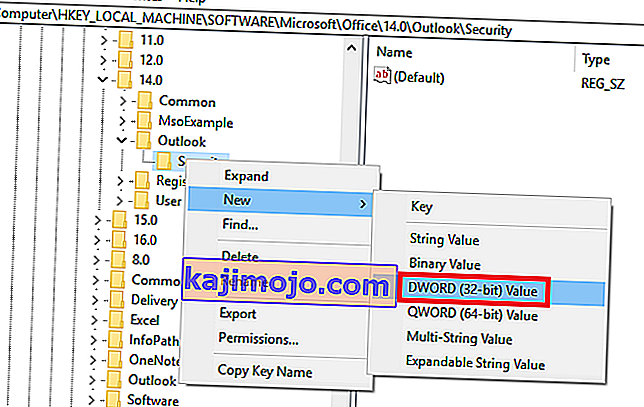
- Name it DisableSafeMode and press Enter to confirm.
- Right-click on DisableSafeMode and click on Modify.
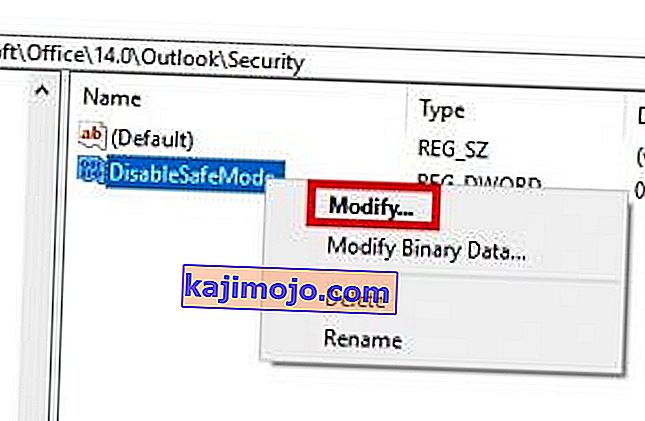
- Ievietot vērtību 1 Jo vērtība datu lodziņā un noklikšķiniet uz Labi .

- Aizveriet reģistra redaktoru un restartējiet datoru.
- Atveriet programmu Outlook un pārbaudiet, vai tā darbojas normālā režīmā.






 Piezīme. Vēl neesiet nospiests Noņemt . Vispirms mums jāapstiprina, ka viņi izraisa šo problēmu.
Piezīme. Vēl neesiet nospiests Noņemt . Vispirms mums jāapstiprina, ka viņi izraisa šo problēmu.




 Piezīme. Pārliecinieties, vai nedarbojošais Outlook, kas iepriekš tika atvērts drošajā režīmā, ir aizvērts, jo tagad mēs izmantojam vienu no iepriekšējās versijās saglabātajām kopijām. Dariet to pašu visām tur uzskaitītajām versijām. Atveriet / aizveriet, līdz redzat to, kas tiek atvērts bez drošā režīma. Ja tas patiešām darbojas, turiet logu atvērtu.
Piezīme. Pārliecinieties, vai nedarbojošais Outlook, kas iepriekš tika atvērts drošajā režīmā, ir aizvērts, jo tagad mēs izmantojam vienu no iepriekšējās versijās saglabātajām kopijām. Dariet to pašu visām tur uzskaitītajām versijām. Atveriet / aizveriet, līdz redzat to, kas tiek atvērts bez drošā režīma. Ja tas patiešām darbojas, turiet logu atvērtu.












 Note: If you don’t manage to find the SCANPST executable via the search bar, you need to navigate to the exact location. Here’s a list of the exact locations based on various Outlook versions:
Note: If you don’t manage to find the SCANPST executable via the search bar, you need to navigate to the exact location. Here’s a list of the exact locations based on various Outlook versions:


 Note: Keep in mind that any customization to the navigation pane will be lost after you click on OK.
Note: Keep in mind that any customization to the navigation pane will be lost after you click on OK.








 Note: If the Security folder is missing, Right-click > New > Key and type Security.
Note: If the Security folder is missing, Right-click > New > Key and type Security.

